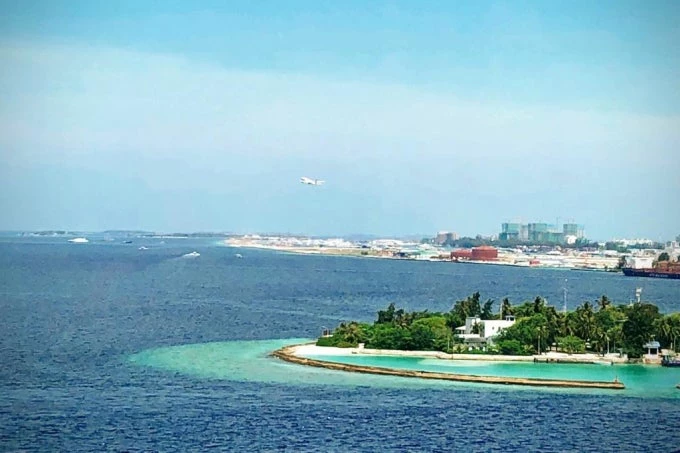
For low-lying island states, the impacts of global warming and climate change can be a matter of survival.
The irony is that while these states have not contributed much to greenhouse emissions, as they produce very little, they may face some of the worst consequences.
Maldives is no stranger to the risks from climate change. It is already witnessing an increase in intense rainfall and resultant flooding, cyclonic winds and storm surges.
As one of the lowest-lying countries in the world, with all its people living a few meters above sea level and over two-thirds of its critical infrastructure lying within 100 meters of the shoreline, a sea level rise of just a few meters will put the nation further at risk, endangering its relative prosperity.
Thankfully Maldives is beginning to turn the tide.
Yesterday I visited Fuvahmulah, in one of the southernmost atolls where the Mayor and the Ministry of Environment, have been working closely with local communities to manage the wetlands, critical for reducing climate change impacts.
I saw scores of young Maldivians enjoying the facilities and learning about conservation. A true win-win. Community participation has helped enhance the design and acceptability of this initiative.
Scaled up, such initiatives can have a transformational impact and it is imperative that the Government of Maldives take the lessons from this Bank supported initiative to 19 other atolls.
Creating a safer archipelago
The Indian Ocean tsunami that battered the islands in 2004 provided a glimpse of what can happen – a clear wake-up call.
The government responded by increasing its emphasis on building resilience in infrastructure and providing its people with early warnings in the event of an underwater earthquake.
Today, in the Greater Malé region, the reclaimed island of Hulhumalé is being developed with better sea defenses and elevated buildings from where people can be evacuated as needed.
The government is also raising people’s understanding of the causes and effects of natural disasters, particularly those that come on suddenly, such as tsunamis and flooding.
It is also realizing that concentrating its citizens in Male has its own negative impacts, leading to overcrowding in a very small space with limited amenities.
As a result, it is now looking to develop regional centers that allow people to move from fragile and high-risk islands and atolls into more manageable enclaves where they can also benefit from access to jobs, services, and resilient infrastructure.
Regional development is being complemented by large scale infrastructure development in the Greater Malé region.
But, as in other small states, building resilient infrastructure in the Maldives is expensive.
It is expected to cost the country around 35 percent of Gross Domestic Product (GDP) to ensure that the expanded international airport, the proposed network of bridges between Greater Malé’s islands, and relocation of the port are up to desired standards.
Building fiscal resilience
To support the cost of constructing high resilience infrastructure, the country needs to be fiscally robust.
Low fiscal strength significantly reduces a country’s ability to recover from disasters, provide its citizens with a safety net and prepare for future disasters.
For the Maldives, protecting the tourism sector, which generates 33 percent of GDP, will be paramount. It’s safe to say that the Maldives is on many a bucket list – but that will stay the case only if those natural resources are protected and remain accessible.
Like many countries of its size, the Maldives has had to borrow heavily to sustain its development.
But while its debt to GDP ratio of about 60 percent is not alarming, it will only remain so as long as tourism revenues don’t fall, disasters don’t hit, and the country does not need to reinvest at an even higher cost to remain resilient.
But the country is not without options. Fiscally, it can reduce its expenditures on imported diesel by replacing it with renewable energy. The Maldives is endowed with abundant sunshine and is overcast only a few times in the year.
And solar energy has become cheap to generate and store.
Estimates show that rooftop solar power alone can meet 30 percent of the electricity needs on some islands, and as much as 80 percent on others.
The Bank has been working with the Maldives to increase the use of renewables and has invested in a $16 million solar power project on the islands of Male and Hulhumale in the Greater Malé region. This is the future for the Maldives.
Providing safe drinking water and protecting the pristine environment
An additional existential risk is access to freshwater – again not limited to the Maldives alone.
Water shortages on the outer islands are a norm, even before things get worse.
A 10-day water crisis in 2014, from failed desalination in Male, cost the country a staggering US$20 million in relief operations.
With limited groundwater reserves and climate change leading to longer dry seasons, water resources are likely to deplete further, especially in the outer islands where little land is available for storing rainwater. While the World Bank is partnering with the government to prepare and implement an urban development project that increases access to water, more will still need to be done.
With higher standards of living - Maldives’ GDP increased from $268 in 1980 to more than $11,000 in 2017 - the scourge of waste is not far.
While solid waste is a growing challenge worldwide, its management is particularly acute on small islands where it can’t be hidden – oftentimes from the very resorts that entice tourists to the Maldives in the first place.
The resort islands that house well over 1 million guests annually and the growing number of guest houses have a flip-side - poor management of wastewater and solid waste. This is the next frontier that the Maldives will need to tame.
The Bank is working in partnership with the government to help address these issues; but the solutions largely lie in reducing the amount of waste, particularly plastic waste, as well as composting the high-volume household waste.
Greater citizen engagement
A poignant lesson learned for surviving on small islands is how well one can get citizens to own the problems and the solutions. People need to understand their exposure and vulnerability, and what they can do to help not only prevent the worst catastrophes but also build their own resilience to them.
Together, the Bank and the government are looking at various options to help the Maldives plan better for eventualities, recover quicker and prevent a recurrence.
But without citizen involvement, these investments will amount to naught. Giving citizens a voice is critical to help any government manage climate risks.
In the end, it comes down to a partnership between technical gurus, the government making the right policies and putting the right incentives in place, the private sector understanding its role and seeing itself as part of the solution, and all stakeholders embracing the issues and the solutions.
Ultimately, the existential challenge is for everyone.


Join the Conversation